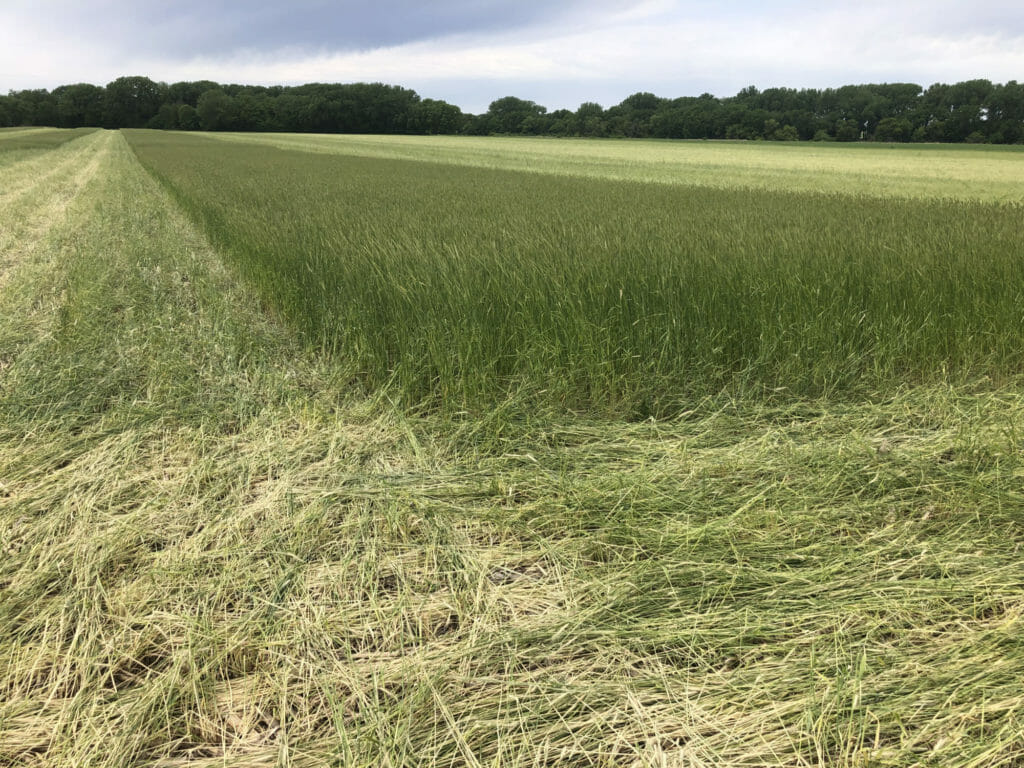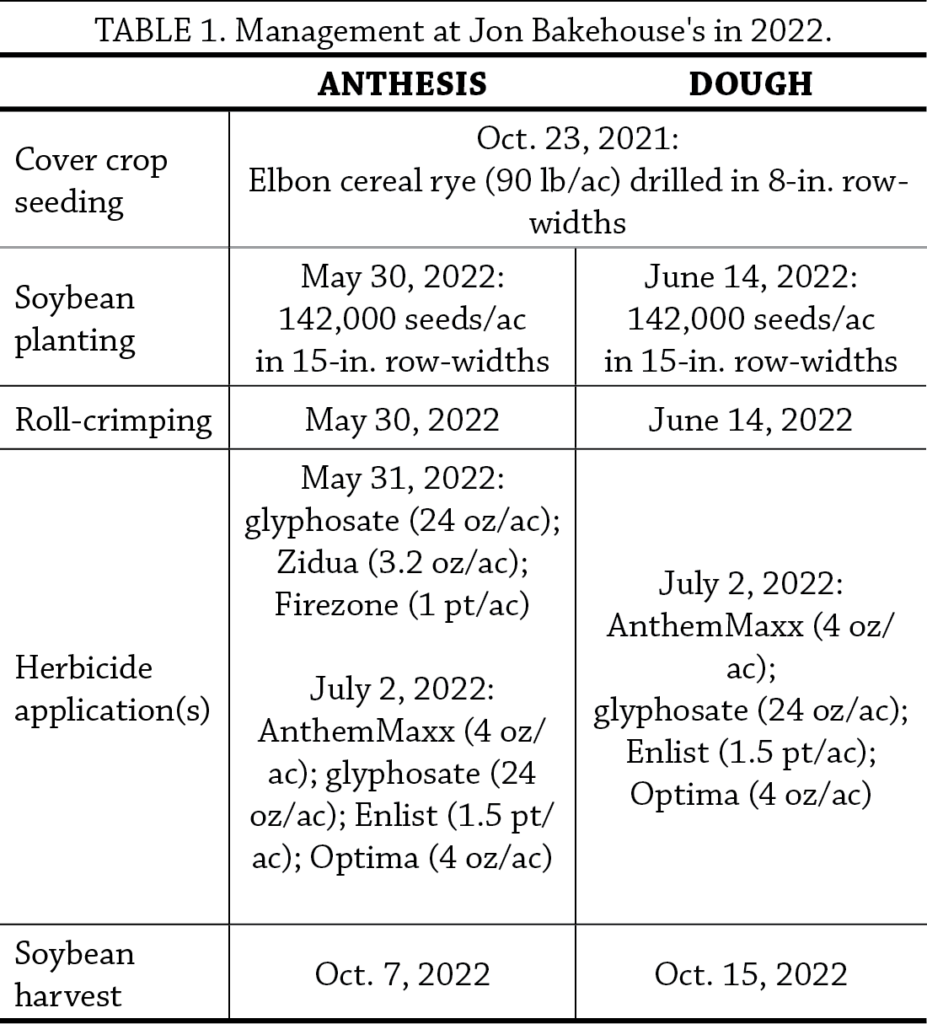This research was funded by Walton Family Foundation.
In a Nutshell:
- Jon Bakehouse has been intrigued by the organic no-till movement which emphasizes the elimination of both chemical and tillage inputs in crop production. He recently purchased a roller-crimper and wanted to know how it might best be used to terminate a cereal rye cover crop in the soybean phase of his crop rotation.
- Bakehouse compared two roll-crimping + soybean plant date combinations that reflected two stages of cereal rye cover crop’s development: (1) plant soybeans and roll-crimp the cover crop at the anthesis stage of cereal rye; and (2) plant soybeans and roll-crimp the cover crop at the dough stage of cereal rye.
Key Findings
- Soybean yield was reduced by nearly 8 bu/ac where Bakehouse roll-crimped the cover crop and planted soybeans at the dough stage compared with the anthesis stage.
- The Dough treatment incurred less costs (less herbicide used) but the Anthesis treatment scored greater net returns by $81.14/ac.

At left, a strip from the Anthesis treatment that was planted to soybeans and roll-crimped on May 30, 2022. At right, a strip from the Dough treatment that was not yet planted or roll-crimped. Photo taken on June 1, 2022.
Background
Much of the academic research on organic no-till and the use of roller-crimpers over the past 12 years has occurred in the Midwest[1-3] and mid-Atlantic[4-6] regions of the U.S. Across these research teams is a common thread: organic no-till is predicated on cover crops for soil fertility and cover crop mulches for weed control rather than frequent tillage (i.e., cultivation). The research is also clear that successful weed control with cover crops relies on consistent, thick cover crop biomass and effective mechanical forms of cover crop termination (e.g., roller-crimpers). In nearly all instances, researchers encourage further investigations into cover crop species selection; cover crop seeding dates and rates; cash crop planting dates; and mechanical cover crop termination methods and dates. Though not a certified organic farmer himself, Jon Bakehouse wanted to contribute to the growing body of research on organic no-till after purchasing a roller-crimper. With the directions for further study suggested by the aforementioned researchers in mind, he asked in the context of his family’s farm in southwest Iowa: When is the right time to plant soybeans and roll-crimp a rye cover crop?
Methods
Design
Following corn harvest in 2021, Bakehouse drilled a cereal rye cover crop from self-raised seed (cv. Elbon). In spring 2022, he compared two roll-crimping + soybean planting dates based on the developmental stage of the cereal rye cover crop:
1. Anthesis (May 30, 2022):
• When rye cover crop has reached 80% anthesis, plant soybeans and immediately roll-crimp rye cover crop.
2. Dough (June 14, 2022):
• When rye cover crop has reached dough stage, plant soybeans and immediately roll-crimp rye cover crop.
For both treatments, Bakehouse planted the same soybean variety and planting population. He implemented four replications of the two treatments (Figure A1) in strips measuring 30 ft wide by 1,958 ft long. Field management is presented in Table 1.
Measurements
Just prior to roll-crimping on either date, Bakehouse collected samples of aboveground cereal rye cover crop biomass from six random locations across all strips. Each sample represented one ft2 and all samples from either date were combined before drying and weighing – this precluded statistical analysis but illustrated the differing amounts of cover crop biomass at the two dates nonetheless. Bakehouse harvested soybeans and recorded yields from each individual strip on Oct. 7, 2022 (Anthesis) and Oct. 15, 2022 (Dough). Yields were adjusted to 13% moisture.

Roll-crimping the cereal rye cover crop at dough stage occurred on June 14, 2022 at Jon Bakehouse’s.
Data analysis
To evaluate the effect of treatment on soybean yield, we calculated the least significant difference (LSD) using a t-test at the 95% confidence level. If the difference between the two treatments was greater than the LSD, we would expect such a difference to occur 95 times out of 100 under the same conditions – we refer to this as a statistically significant effect. On the other hand, if the resulting difference between the two treatments was less than the LSD, we would consider the results to be statistically similar. We could make these statistical calculations because Bakehouse’s experimental design involved replication of the treatments (Figure A1).
Results and Discussion
Cover crop biomass
From the samples Bakehouse collected just prior to roll-crimping on either date, the cover crop produced 3,809 lb/ac biomass in the Anthesis treatment and 5,714 lb/ac in the Dough treatment (Table 2). The cereal rye in the Dough treatment, roll-crimped two weeks after the rye in the Anthesis treatment, experienced 570 additional growing-degree days (base=32°F).
Soybean yield
Soybean yield was reduced by nearly 8 bu/ac where Bakehouse roll-crimped the cover crop and planted soybeans at the dough stage compared with the anthesis stage (Figure 1). Recall that these two stages occurred roughly two weeks apart (May 30 vs. June 14; Table 1) and the later planting date in the Dough treatment may have contributed to reduced yield. The Dough treatment was designed with a later planting date in mind with hopes that roll-crimping the cover crop at the later stage of development would improve termination efficacy. Both treatments, however, required herbicide after roll-crimping to both control weeds and complete termination of the cover crop (Table 1). “Roll-crimp performance [at anthesis] varied,” Bakehouse said. “Crimping [at dough] seemed to perform better, though, a few plants popped back up.” Yields of both treatments were well below the five-year average for Mills County (52.5 bu/ac)[8] and this was likely due to lower than normal rainfall during the growing season (Figure A2).

FIGURE 1. Soybean yields by replication and treatment at Jon Bakehouse’s in 2022. Soybeans in the Anthesis treatment were planted on May 30, 2022 and harvested on Oct. 7, 2022; soybeans in the Dough treatment were planted on June 14, 2022 and harvested on Oct. 15, 2022. Roll-crimping of the cereal rye cover crop immediately followed soybean planting on either date. In the upper left are the treatment averages. Because the treatment averages differed by more than the least significant difference (LSD = 1.5 bu/ac), we consider the treatments to be statistically different at the 95% confidence level.
Economic considerations
The Anthesis treatment scored greater net returns by $81.14/ac (Table 3). The Dough treatment incurred less costs (less herbicide used) and reducing herbicide use by 50% was a goal of Bakehouse’s going into the trial. These savings, however, were not enough to account for the reduced yields and subsequent gross returns compared with the Anthesis treatment.
Conclusions and Next Steps
Bakehouse went into this trial with a desire to learn how roll-crimping a cereal rye cover crop might fit into his family’s farm. The principles of “organic no-till,” which emphasize the elimination of both chemical and tillage inputs, have in recent years piqued his interest. “We now have a good, first answer to our initial question, with ideas and strategies to address a couple of new questions,” Bakehouse said about this trial. “We got solid results along with several ideas on how to improve following trials, as well as ideas for new, related trials,” he added. For one, he intends to repeat the trial in 2023; this time with purchased cover crop seed to ensure consistent germination in the fall and uniform maturity in the spring. Bakehouse noted that the cereal rye cover crop in the present trial was from home-raised seed and did not exactly mature at the same rate and probably contributed to incomplete termination with the roller-crimper in both treatments. Second, because soybean yield was reduced with the later roll-crimping and planting date in the Dough treatment (Figure 1), Bakehouse is going to consider how he can preserve early planting of soybeans while still using the roller-crimper to terminate the cover crop. Visually determining when exactly the cereal rye cover crop reached the anthesis or dough stages proved challenging; paying attention to growing-degree days in the spring may serve as a helpful check for deciding when the cereal rye is ready to roll-crimp. “[This trial] got my creative juices flowing,” he said. “And it prompted even more questions to explore.”
Appendix – Trial Design and Weather Conditions

FIGURE A1. Jon Bakehouse’s experimental design consisted of four replications of the two treatments. This design allowed for statistical analysis of the data.

Figure A2. Mean monthly temperature and rainfall during the trial period and the long-term averages at Red Oak, the nearest weather station to Bakehouse’s farm.[7]
References
- Davis, A.S. 2010. Cover-Crop Roller–Crimper Contributes to Weed Management in No-Till Soybean. Weed Science. 58:300–309. https://pubag.nal.usda.gov/download/45407/pdf (accessed October 2022).
- Delate, K., D. Cwach and C. Chase. 2012. Organic no-tillage system effects on soybean, corn and irrigated tomato production and economic performance in Iowa, USA. Renewable Agriculture and Food Systems. 27:49–59. https://d1wqtxts1xzle7.cloudfront.net/46778368/Organic_no-tillage_system_effects_on_soy20160625-30727-xqu6cv-with-cover-page-v2.pdf?Expires=1651849938&Signature=EnxLJYHF1Npx2KwAA3v29nqeEbE5hyfwaJtqenJ9DcVojoq3pf9F5QtZO86jCiMP1YBvo2hr6VxHjjCytIQ-T2x02JoExV (accessed October 2022).
- Silva, E.M. and K. Delate. 2017. A decade of progress in organic cover crop-based reduced tillage practices in the upper Midwestern USA. Agriculture. 7:1–13. https://www.mdpi.com/2077-0472/7/5/44 (accessed October 2022).
- Mirsky, S.B., M.R. Ryan, W.S. Curran, J.R. Teasdale, J. Maul, J.T. Spargo, J. Moyer, A.M. Grantham, D. Weber, T.R. Way and G.G. Camargo. 2012. Conservation tillage issues: Cover crop-based organic rotational no-till grain production in the mid-Atlantic region, USA. Renewable Agriculture and Food Systems. 27:31–40. https://doi.org/10.1017/S1742170511000457 (accessed October 2022).
- Mirsky, S.B., M.R. Ryan, J.R. Teasdale, W.S. Curran, C.S. Reberg-Horton, J.T. Spargo, M.S. Wells, C.L. Keene and J.W. Moyer. 2013. Overcoming Weed Management Challenges in Cover Crop–Based Organic Rotational No-Till Soybean Production in the Eastern United States. Weed Technology. 27:193–203. https://doi.org/10.1614/WT-D-12-00078.1 (accessed October 2022).
- Wallace, J.M., A. Williams, J.A. Liebert, V.J. Ackroyd, R.A. Vann, W.S. Curran, C.L. Keene, M.J. Vangessel, M.R. Ryan and S.B. Mirsky. 2017. Cover crop-based, organic rotational no-till corn and soybean production systems in the mid-atlantic United States. Agriculture (Switzerland). 7:1–21. https://www.mdpi.com/2077-0472/7/4/34 (accessed October 2022).
- Iowa Environmental Mesonet. 2022. Climodat Reports. Iowa State University. http://mesonet.agron.iastate.edu/climodat/ (accessed October 2022).
- US Department of Agriculture-National Agricultural Statistics Service. Quick stats. USDA-National Agricultural Statistics Service. https://quickstats.nass.usda.gov/ (accessed October 2022).
- Johanns, A. 2022. Iowa Cash Corn and Soybean Prices. A2-11. Iowa State University Extension and Outreach. https://www.extension.iastate.edu/agdm/crops/pdf/a2-11.pdf (accessed October 2022).




